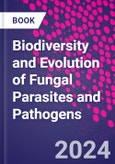Biodiversity and Evolution of Fungal Parasites and Pathogens presents an overview of the biodiversity and complexity of fungal communities that form associations as parasites or pathogens. With only 138,000 described species of fungi and an estimated number of up to 6.1 million, the Kingdom of Fungi is severely understudied. Among the least studied groups are those associated with organisms as parasites and pathogens. Written by an international team of more than 30 research experts, this book introduces devastating diseases such as Batrachochytrium dendrobatidis and Pseudogymnoascus destructans, which both have resulted in dramatic population declines of animal populations, specifically amphibians and bats. In addition, the book discusses economically important parasites of plant crops and pathogens that cause lung infections in mammals. Finally, some of the least studied groups of fungal parasites and pathogens are treated, such as the enigmatic Laboulbeniomycetes fungi. This book is an important resource for researchers and practitioners in mycology, evolutionary biology and biodiversity. It will help readers explore the concept of symbioses by definition and introduce state-of-the-art tools, techniques and next-generation data.
Table of Contents
PART 1 Theoretical contributions 1. Definitions of fungal parasites and pathogens through time 2. Parasites and pathogens in the fungal tree of life 3. Evolutionary and ecological models in fungal parasitism shifting to mutualism 4. Mechanisms of fungal parasitism and pathogenicity 5. Fungal hyperparasites 6. Co-speciation studies: Is there a common trend? 7. The use of phylogenetics and phylogenomics in understanding fungal diversity problems, state of the field, future perspectives 8. Fungal disease dynamics in ecosystems PART 2 Biodiversity 9. Chytrid fungi 10. Understanding obligate biotrophy in Laboulbeniomycetes 11. Entomophthora muscae and Musca domestica: A candidate model system to study host immune responses against fungal pathogens 12. Entomopathogenic fungi and their use in biological control 13. Massospora, obligate pathogens of cicadas 14. Phytopathogenic fungi 15. Ophiocordyceps zombie ant fungi 16. Economically important plant parasites: Rusts and smuts 17. Mycoparasitism in Basidiomycota 18. Medical fungi and human diseases 19. Pneumocystis mammal pathogens








